The first pier in Lorne dates from the 1880s and was always famed for its ‘shapely’ beauty. The 21st century pier is just as popular with fishermen and folk out for a breath of air.
My experience on the pier
It was one of those days when you need to hold onto your hat when I finally got to Lorne Pier. Late summer, it may have been still, but the mountain forest I drove through on my way down to Lorne was thick with cloud and the temperatures were barely hitting 20C with a strong wind blowing off the sea.

The pier was busy, though. Some were just out for a blow (the modern term for a ‘promenade’, I guess) like me, with many sitting on the pier dropping a line into the water to see what they’d catch.
Fishing has always been a big thing off Lorne Pier. And the 21st century seems no different. There are even two levels to this pier as you reach the seaward end, with most of the fishing going on from the lower level.
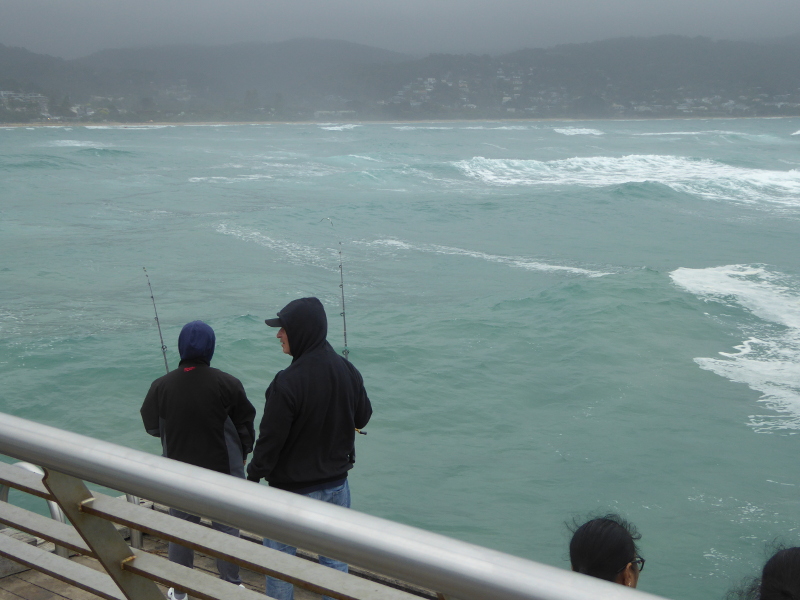
There’s even a full-on tap and sink to wash your catch, though nobody seemed to be using it when I walked by.
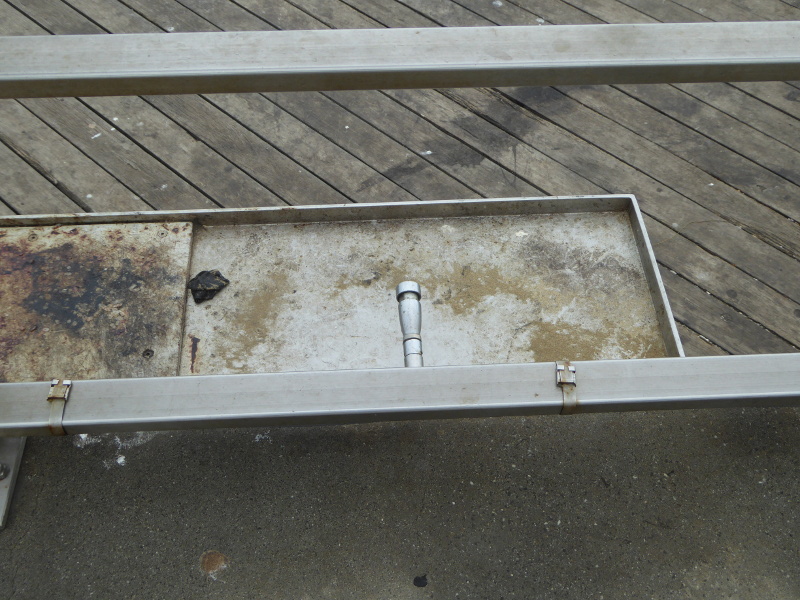
I have a feeling that the 2020 version of Lorne Pier might be a recent construct. The concrete piles look very solid even in a heavy swell as there was off the Southern Ocean the day I was there.
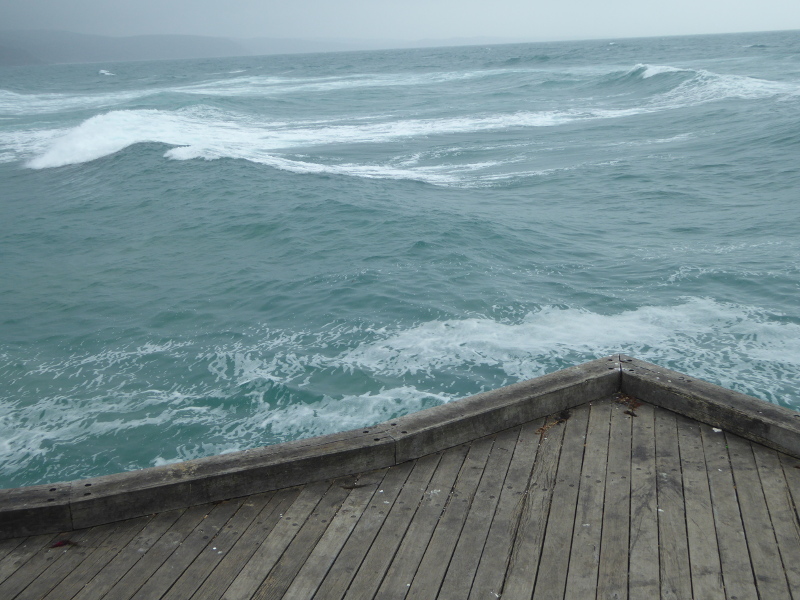
They’ve done a good job of maintaining a vintage feel, though, with boardwalk all the way along, and it is still ‘shapely’ in 2020, though I wonder how much today’s ‘shape’ differs from the 1883 version?
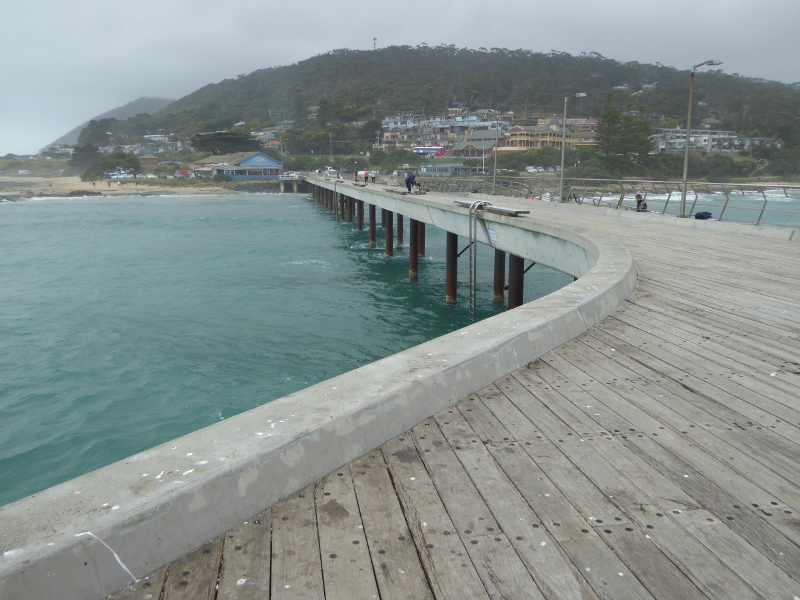
Lorne Pier in 2020 has a rather lovely curve, and there is another curvy bit at the end rather than what was once an L-shape in the pier’s earlier days.

As I arrived at the end of the pier, there was quite a crowd gathered, all looking in the same direction. Nothing to see, as far as I was concerned, but when I heard one couple saying, “Well, that was a bonus,” I couldn’t help wondering what they had all seen.
So, in line with the great tradition (see the story below in History) of talking to strangers on Lorne Pier, I asked one lady what she had seen. A seal, she reckoned. Her accent intrigued me, and I discovered that she was with her husband on a trip from the Netherlands, but had been visiting her daughter who manages the Meredith Cheese Factory.
Now, funnily enough, only a small coincidence compared to the ones reported on in 1925, but I had just driven past the sign for Meredith Cheese that morning on my way to Lorne, and had taken a mental note to try their cheese one day, as I’d never heard of it before.

Anyway, by the time I got to the end of the pier, the seal had vanished, and the only wildlife to be seen were the birds. There are lots of birds, though. All perched on vantage points to pick up a few fish before the anglers get their hooks into them.
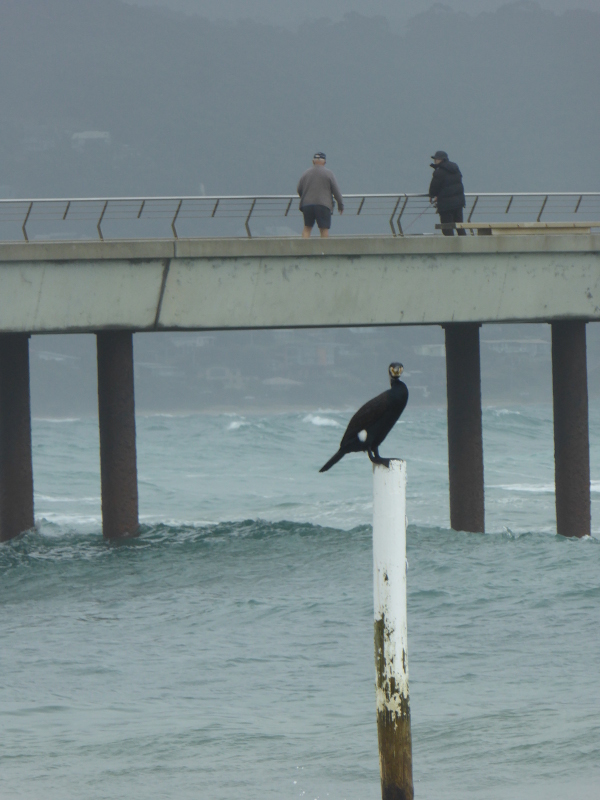
There’s not really any shelter on Lorne Pier (I guess with the wind in certain directions, you could huddle down on the lower level), but there are lots of benches towards the sea end.

And sets of vertical steps down into the water, I guess for those boarding boats by the pier, though it seemed a fair drop from the pier to the water, and I wouldn’t fancy boarding that way.
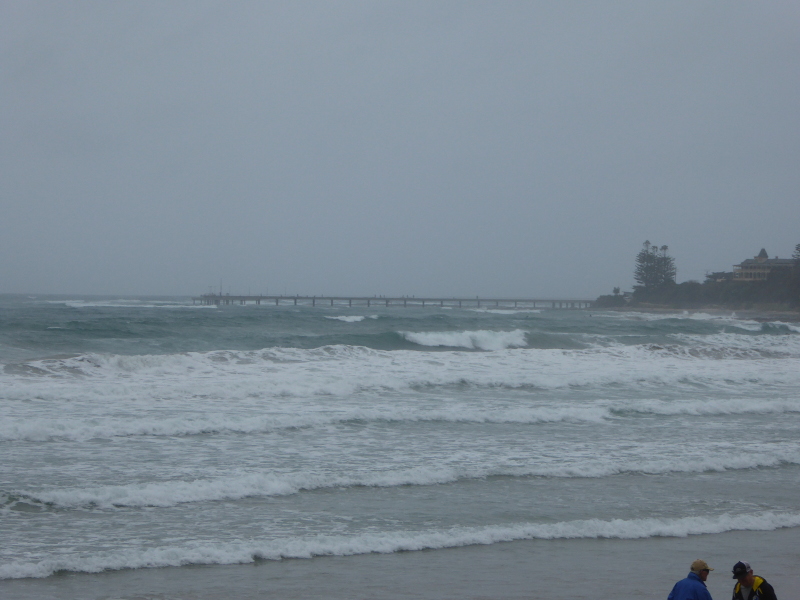
Lorne Pier is about a kilometre round the bay from Lorne Beach and the main township.

Just above the pier onshore, though, is the Grand Pacific Hotel, which has been there since before the pier was first built. It’s so nice that it still looks down on Lorne Pier, and I think we might come and stay there, when we return to Lorne for another Vintage Victoria trip (to review the Lorne Theatre).
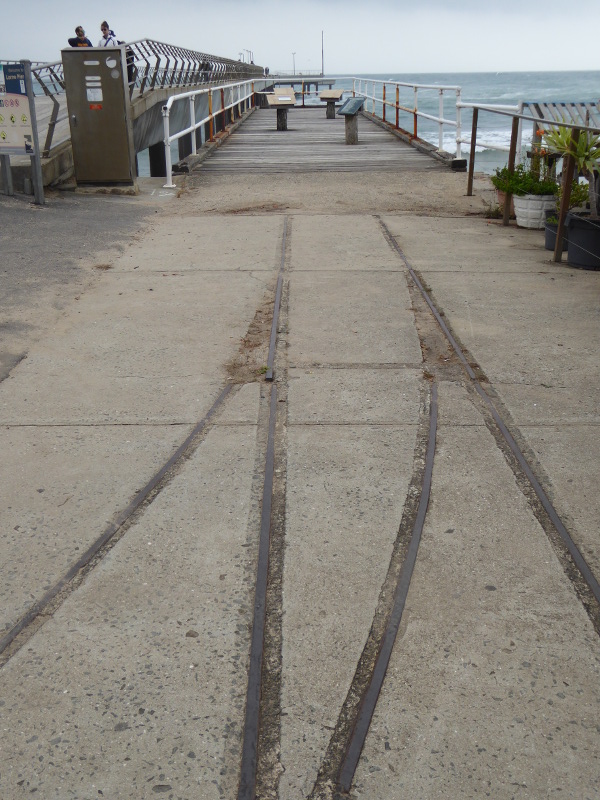
Back at the start of the pier, there is a lower level short pier section alongside the main pier.
I wondered if this might have been the site of the original Lorne Pier, especially as it had rail tracks heading towards it from the land (though I read nothing of rail connections to Lorne Pier on Trove, so if someone can fill me in on the history there, I’d love to know).
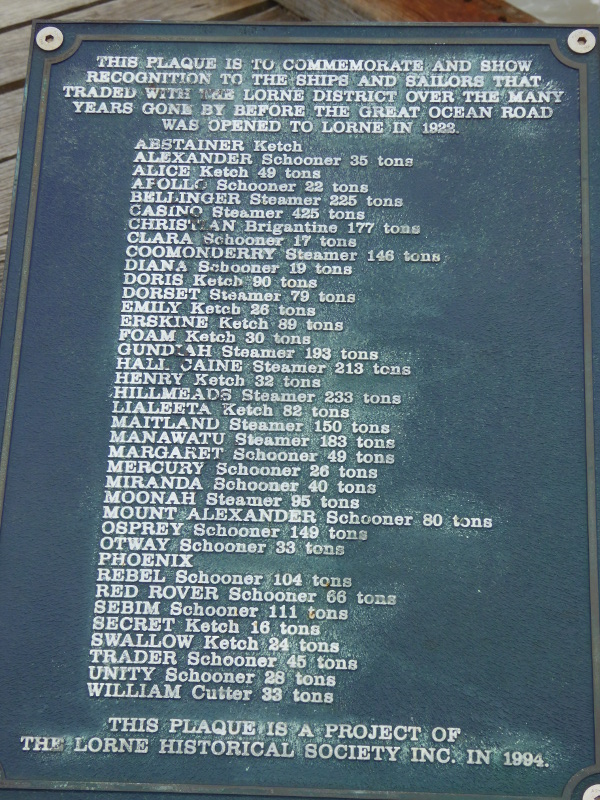
I liked the list of ships that used the pier in the days before the Great Ocean Road was built in 1922. It shows a sense of the pier’s place in history, and made me realise just how isolated Lorne must have been in the early days.
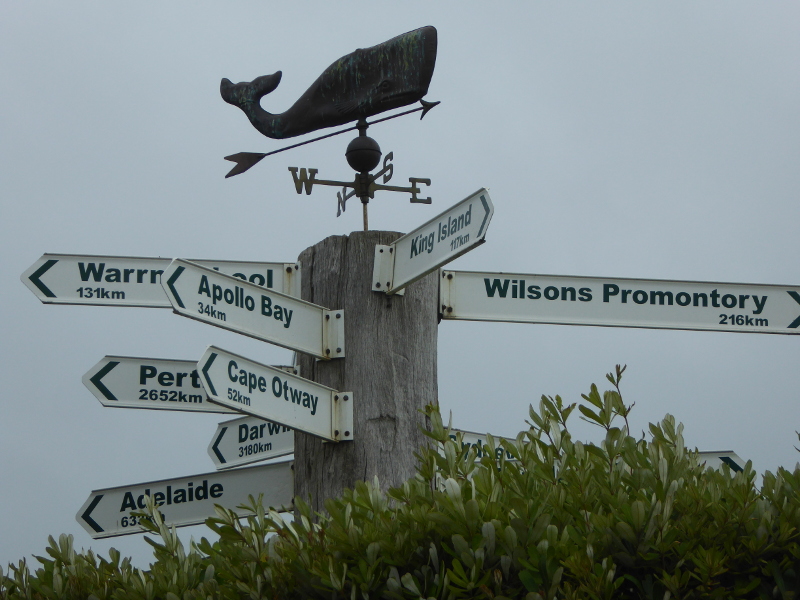
I also kind of liked the gimmicky signpost with directions to places around Australia. I think it gives places like Lorne Pier a sense also of its place in the world (or at least on the Australian continent).
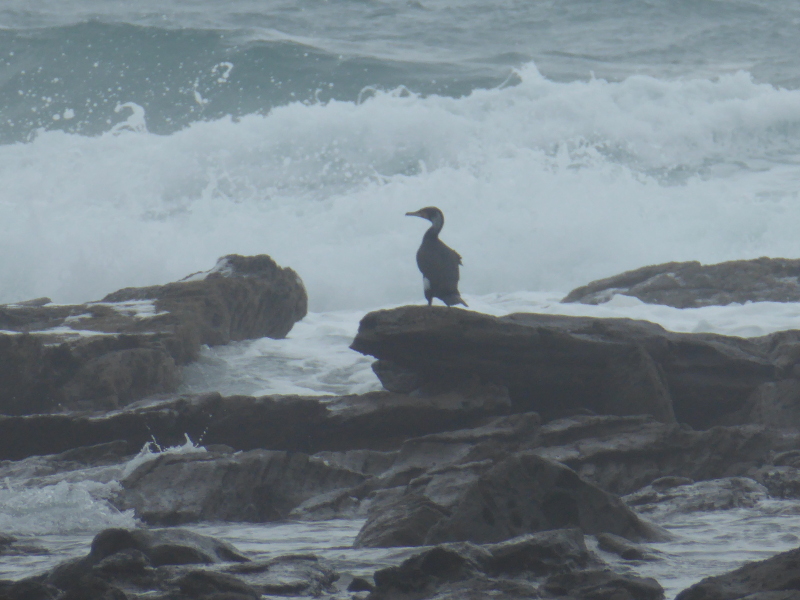
With the tide out, I was able to scramble a bit along the rocks next to the pier, in the vague hope of spotting some basking seal out there, but no luck today.
It is a nice spot, though, and the kind of place the young kid in me used to love to visit to fossick about in the rock pools.
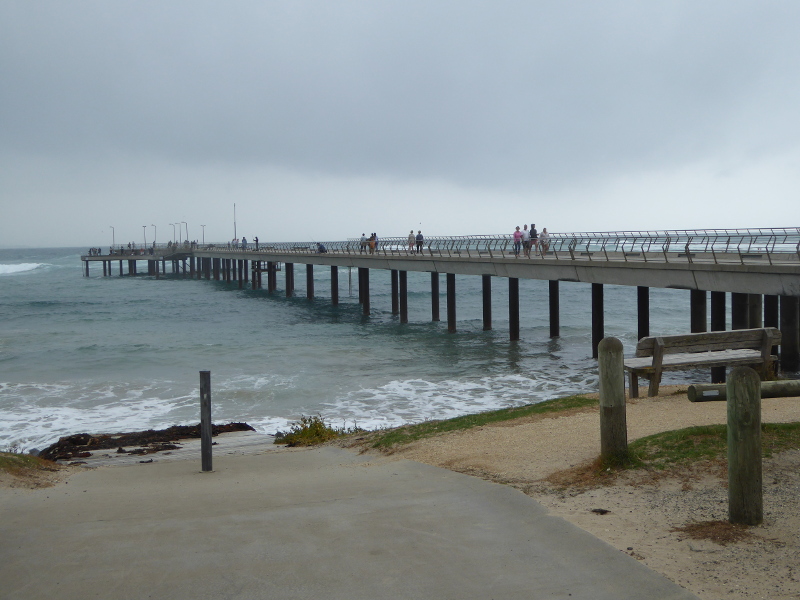
So, no seals, sharks or whales to be seen for my visit, but I really liked Lorne Pier, and I’m clearly not the only one who feels that way.
Practicalities
Toilets not far from the pier at the shore end
Benches along the pier but no shelter from rain or sun.
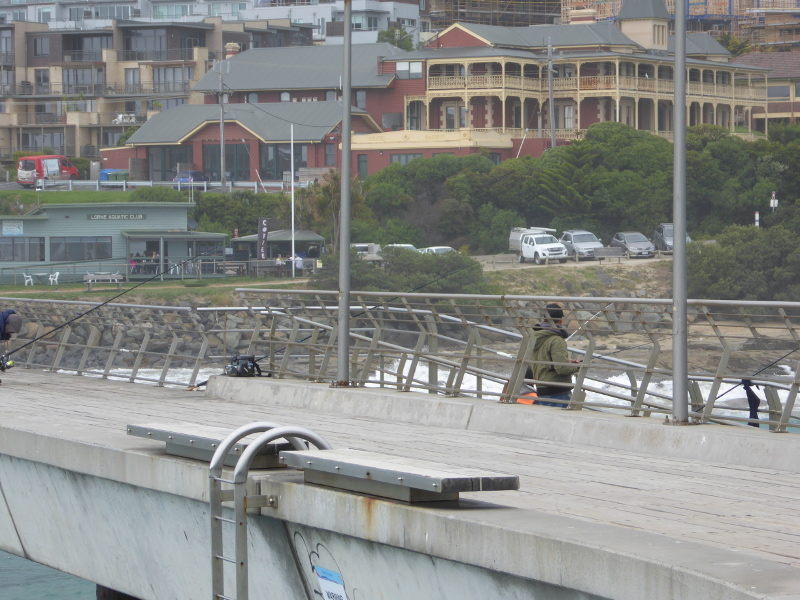
Pier about 200-250m long, with a 40-50m curvy cross-section at the end
Parking a bit limited but I did get a spot near one of the cafes by the pier.
History and stories about Lorne Pier
Lorne’s first jetty was built in 1879, but there were immediately complaints that it was not long enough at that time to allow steamers to berth.
Lorne’s ‘shapely pier’ got a mention in the Camperdown Chronicle in 1883. An article in The Argus from April 1882 spoke of the Grand Pacific Hotel (still there today) commanding views of the pier. Another article spoke of the pier being about 200m long, with an additional 40m L shape. But the same piece bemoaned the lack of steamers visiting Lorne and therefore reducing the potential number of visitors.
A visitor in 1890 waxed lyrical about Lorne in The Argus newspaper: “From every coigne (sic) of vantage, from every seaward-facing window, from the pier-head or the wave-washed beach, a scene of ever-changing never-satiating beauty greets the eye.”
So fishing off Lorne Pier was always a major activity. One report from 1897 said that “Scarcely a day passes without a shark being caught from the pier’. So sharks were often seen as a good catch rather than a risk to bathers…
An early news story concerned a 5m shark caught off the pier using a type of clothes line to haul it in. They wouldn’t do such a thing these days, but the report in The Argus said the 32 shark’s teeth were each fetching half a crown, and sales were brisk.
A 1924 fishing report in The Australasian said: “Sharks and other vermin (sic) are very numerous about the Lorne pier, and tackle must be of good strength if an angler wishes to land all he hooks.”
The fishermen were not always happy with their lot, though: In 1936, they complained of inadequate crane facilities to haul the 14 local boats onto the pier in a storm.
And storms over the years were the other recurring theme for Lorne Pier.
In 1911, it was said to be a tricky pier to berth alongside in stormy weather. In the early 1920s repairs were started on the badly-decayed timbers on the Pier. News clippings spoke of the difficult task of sawing piles which were a foot below low tide mark so always submerged.
A big storm in March 1932 saw waves breaking over the pier and a kind of tidal wave taking water up the river for a mile. Then, five days of storms in 1933 left the Lorne Pier in tatters, with piles poking out at strange angles, with fears the pier could collapse completely.
The latest stormy stories I found on Trove came from the late 1940s: A brief but ferocious hurricane hit Lorne in 1946. Three fishing boats were blown off the pier into the water and onto a reef; shelter sheds at the shore end were destroyed; and one poor fishermen got a broken nose when he failed to dodge a flying fish box on the pier. Another big storm in 1948 led to reports that Lorne Pier lay under 10 feet of water at the height of the storm.
Funnily enough, the most notorious shipping incident off Lorne Pier concerned smoke haze rather than heavy seas. Bushfires nearby in 1908 caused a boat to run aground near Lorne Pier that year.
Most of my other favourite stories linked to Lorne Pier were about people or wildlife, although in some cases the people were the wildlife…
In January 1908, three youths from Lorne were charged with behaving in an ‘insulting’ manner by driving a truck at breakneck speed up and down the pier, alarming and threatening life and limb of those who happened to be on the pier at the time.
A whale came in very close to the pier in 1909. It was covered in barnacles, apparently, and in trying to shake them off, caused the pier to tremble. It left for deeper waters and towards Apollo Bay about 5pm!
The 1920s saw the arrival of the great swimming family, the Beaurepaires (later got into tyres and vehicle maintenance), when the father of world champions Frank and sister Lily bought a guest house in Lorne. The Beaurepaire siblings began demonstrations of swimming and diving off the Lorne Pier in front of an Easter crowd of 500 in 1920. And there were several acts of bravery from both of them (though more often Lily than Frank) in life-saving off Lorne Beach.
Frank Beaurepaire was a bit of a veteran swimmer by 1923 when he put pen to paper to write to The Argus in Melbourne as Honorary Treasurer of the Lorne Life Saving Club. He wanted to correct any impression given in an earlier edition that Lorne’s waters were not safe, citing money raised from swimming demonstrations off the pier to fund the erection of a tower with a safety bell 30ft high to alert the town in the case of a person struggling at sea…
I loved the 1925 story of ‘Coincidences’ reported in The Australasian. These were all to do with chance meetings and conversations resulting in connections made and coincidences that often occurred across the other side of the globe. One such came from Lorne Pier, where two Irishmen who did not previously know each other got into conversation and discovered that they had both been involved in a boat that sank off the Irish coast on a section of coast that resembled the area near Lorne. One had survived the sinking; the other had narrowly missed the boat and thereby saved his life. So it can be worth saying more than ‘hello’ to fellow pier promenaders or fishermen – and I was rather glad I tried my own little bit of a connection on the pier in 2020…
Finally, I loved the 1940 feature in The Age, which spoke of Lorne Pier. Beyond the pier is a reef, which at one time it was proposed to extend the pier into a breakwater. “If you want to fish off the pier, you will meet a master of ceremonies, the man who fished there when Lorne was known as Rooke’s Hotel. He knows the reef and the kind of fish to fish for, and he wears the old school tie, a friend to any visitor who would laze around the pier for hours… Who was he, and when did he stop welcoming folk to the pier??
Other links and writings on Lorne Pier
The Don’t Forget to Move travel blog has a nice post on Lorne Pier.
This Ocean Fit blogger wrote about the Lorne Pier to Pub swim.
The Pier to Pub Swim even has its own Facebook page.
This fishing website shows an amazing set of fish species caught off Lorne Pier in this post
This local Lorne website wrote on the history, including on the new pier built some 10 years ago.
This Chat By Lane website post is about the pier and the clifftop walk, which sounds a must-do one day.
What are your stories and memories of Lorne Pier?
Does anyone have memories of the old Lorne Pier and can tell us how different it was to the new version? Also, what sort of vehicles used those rail tracks onto the old pier and when did they stop?
Anyone want to share their experience of doing the Pier to Pub swim from Lorne Pier? What’s it like to do that in a strong swell?
Or just share any stories of your own favourite times on Lorne Pier (ld or new), especially if you have any good stories to fill in my gaps after the 1940s..
Coffee or tea near the pier?
I didn’t really get a chance to explore coffee in Lorne, so what’s your favourite place? And has anyone had the coffee at one the cafes by the pier?

